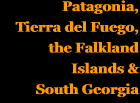Southward, somewhat erratically!

Starting work on the north-south 'trunk' line
The nascent 'Ferrocarriles de Estado' Patagonian network found itself in mid-1922 with a rapidly increasing stock of engines and equipment at Puerto Madryn, and a need to get started on the construction of its new network. Whilst work moved ahead smartly on the regauging and extension of the FCCC, there was a desire to attack the problem from another starting point.
From nowhere...
The plan chosen was to build southwards from Ingeniero Jacobacci on the planned broad gauge route to Bariloche. As the map on an earlier page showed, the intention was to head southwest towards Trevelin (otherwise known as Colonia 16 de Octubre), with branches being sent off westwards to Epuyen and Esquel. It was no doubt expected that near Trevelin or Tecka the newly-extended FCCC would be met and that the track gangs could then turn south-eastwards to meet the isolated broad gauge lines at Sarmiento and Las Heras.
The various laws and decrees which made the construction of the line possible.

... to nowhere!
Work began 16km. west of Ingeniero Jacobacci at Huanu-Luan in the middle of nowhere. Progress is recorded as being extremely slow, and by the time that economic depression stopped all work in 1929, only 25 miles (40 km.) had been completed.
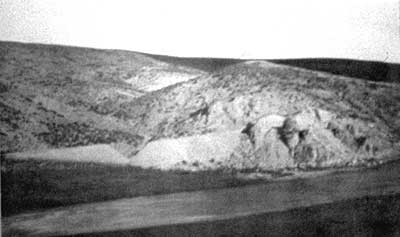
Here is one photo taken during the building period, showing an embankment in course of construction alongside the Rio Chico. A number of other construction photos are set out on an appendix page.
A fresh start on a new route
Whilst work was at a standstill, some of the very lightly-built earthworks and bridges were washed away by floods. This prompted a rethink, and when Law 11735 provided new funds to restart work in 1932 the route had been radically altered. From Km. 63 a new course was followed, much further west and heading towards Ñorquinco, El Maitén, Esquel and Trevelin.
By this time all thought of reaching the southern broad gauge lines had been abandoned. However, the northern broad gauge had moved on beyond Ing. Jacobacci, so there was a renewed sense of being part of a major scheme to spur the work on. When lack of money had curtailed the original expansive plans, a decision had been made to give Esquel a route out northwards rather than east to Puerto Madryn. This was favoured by those wanting a link to the cities further north and to a frigorífico, but was a bitter disappointment to the inhabitants of the Chubut Valley
The new route was surveyed and built to a higher standard, avoiding points liable to flash flooding. The result was some heavier earthworks, and one or two spectacular features, such as a 105m. granite-bored tunnel and a similar length single span bridge over the Río Chico. A table listing the features of the line is in an appendix page. A more detailed description of the route and its features can be found in Keith Taylorson's book Narrow Gauge Rails to Esquel (1).
The Esquel route as eventually completed.
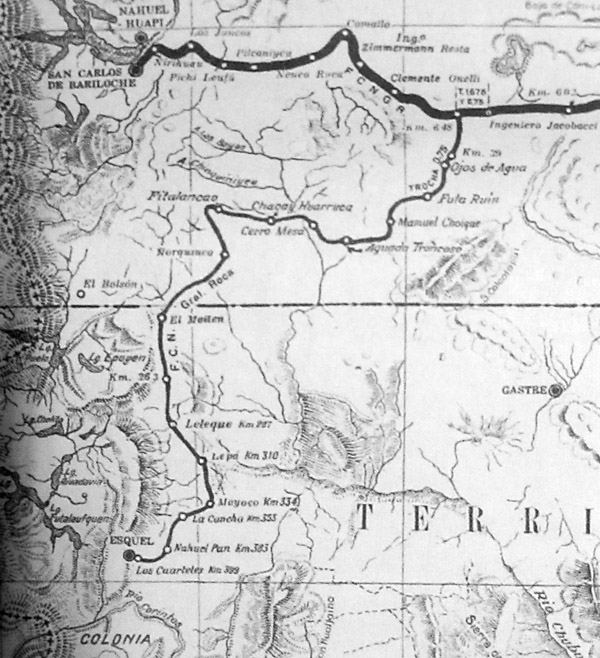
Further tranches of money were released by laws 12576, 12815 and 13494 (2) and from 1936 sections of the railway could at last be opened: from Ing. Jacobacci to Km. 106 initially, and then to Ñorquinco in 1939, El Maitén in 1941/2 and Esquel in 1945. Esquel station was built to allow extension further, to Trevelin, but the funds were never found. Interestingly, a 1947 history of Argentinean railways, published by the FCE, talks as if a short branch was still to be built from El Maitén to Cholilla (3).
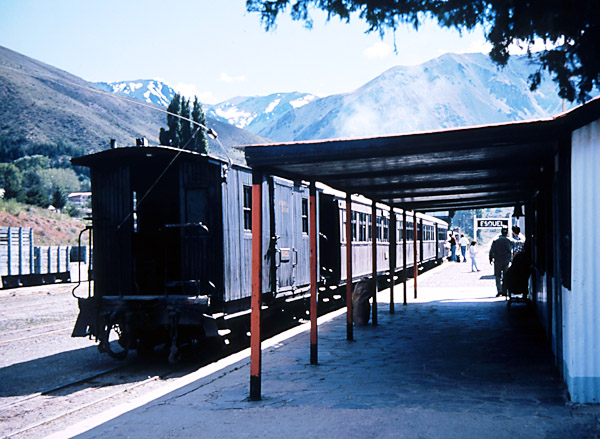
A 1995 photo of Esquel station, by Andy Kirkham.
Tracing the route using Google Earth
Readers who have the Google Earth program can right click (control-click on a Mac) on the following link:
Ing Jacobacci a Esquel on Google Earth.zip
Save the file to your desktop and double-click to decompress it. Open the folder and drag the KMZ file onto Google Earth's Places palette. You will now find that you have placemarks for each of the main locations along the route, and three paths to enable you to 'fly through' the route as if in a helicopter. Select one of these and click on the start button to commence the flight.
• Ing. Jacobacci a Cerro Mesa A flight along the first operating division of the Esquel route, from Ingeniero Jacobacci to Cerro Mesa.
• Cerro Mesa a El Maiten The second operating division, in rather more rugged terrain.
• El Maiten a Esquel The final operating division, to the terminus at Esquel.
Generally the route is clearer without the overlying vector path being checked and visible, but with the appropriate station placemarks checked. Flights or 'tours' in this website are best done with the Google Earth touring preferences set to a camera tilt angle of about 60 degrees, and a camera range of about 300m.
"Fly-throughs' on such long routes as this one can be extremely tedious unless the Google Earth preferences are set to a fairly high speed. If looking for a particular location you might be better advised to click on a named placemark. However, the monotony of following the trackbed across the bare pampa for hundreds of miles does at least give a clear impression of the problems of making such a railway pay its way.
|
Locomotives
The first six of the Baldwin 2-8-2s were unloaded at San Antonio (Oeste) for erection and transport direct to the new line (4). As the line progressed rails, more locomotives and rolling stock were supplied from the Puerto Madryn store.
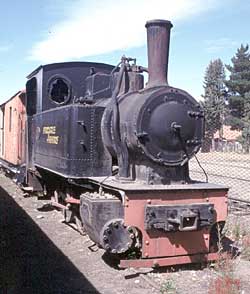 The 1940 'Estadística' report suggests that two of the Henschel 2-8-2s were employed on public trains by then whilst five more and one 0-6-0T were being used by the line builders (5). Interestingly it does not report on the Baldwins at all. The 1940 working timetable booklet for the FCCC rather strangely gives details of the 12 oil and 9 water tank wagons sent to the new section, but mentions no others. It may have been that these were taken from the FCCC's working stock, whilst the others came nominally from the Puerto Madryn store of new and unused equipment. The 1940 'Estadística' report suggests that two of the Henschel 2-8-2s were employed on public trains by then whilst five more and one 0-6-0T were being used by the line builders (5). Interestingly it does not report on the Baldwins at all. The 1940 working timetable booklet for the FCCC rather strangely gives details of the 12 oil and 9 water tank wagons sent to the new section, but mentions no others. It may have been that these were taken from the FCCC's working stock, whilst the others came nominally from the Puerto Madryn store of new and unused equipment.
The sole Henschel 0-6-0T to have come from Puerto Madryn seems to have become the El Maitén works shunter after the construction of the route had been completed. It remains there now but has not steamed for some time.
In the early years all loco overhauls were carried out at San Antonio Oeste on the broad gauge, but from 1950 onwards a new works was built up at El Maitén part way along the new line.
Once the line was opened to Esquel, and later after the closure of the FCCC in 1961, more engines arrived. The 1922 Locomotives page gives full details but in summary El Maitén works eventually received at least 15 of the 25 Baldwins, at least 26 of the 50 Henschels and one of the 0-6-0T shunters (19454). The was a certain amount of interchange of locos at various times, particularly when some of the Henschels went to the Río Turbio line in 1950 and later when one or two of them returned.
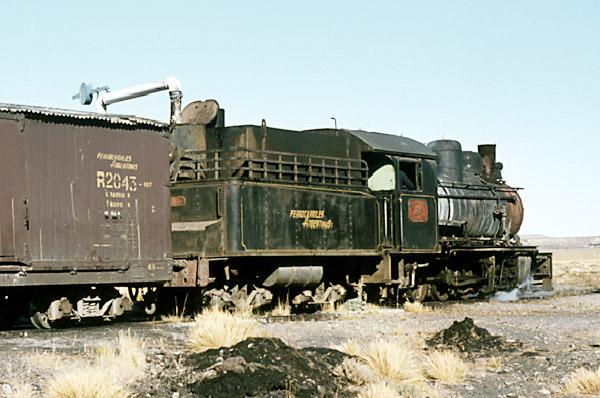
A Henschel takes water whilst on a mixed train in 1975. The Henschels were mostly used at the Esquel end of the line, and the Baldwins at the northern end.
Passenger and freight cars
The line's rolling stock has been made up almost entirely from the 1922 Familleureux stock ordered for the proposed network. See the rolling stock page which covers this in detail. More of this was brought from Puerto Madryn as needed. However, in the 1960s several new first and second class coaches were built on old underframes, and a pair of dining cars. Another new 2nd class coach is currently being built at El Maitén works.
Modified vehicles
Inevitably over the years some of the original very standardised 1922 vehicles have been adapted for new purposes. The photos below show a selection of those so altered on the Esquel line.
A second class car constructed on a 1922 wagon frame. Note that this vehicle effectively has no doors, and relies on its neighbours to provide means of boarding and alighting.
|
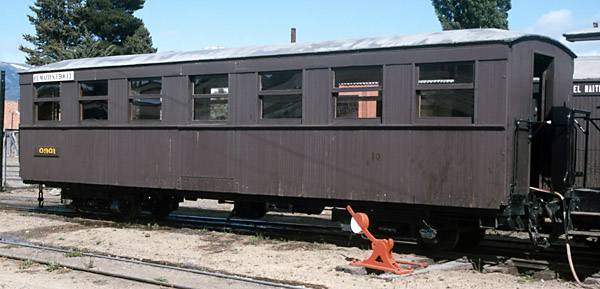
|
That is all very well for a single vehicle but the new coach being constructed in December 2000 will have steps and an end platform. This vehicle, like the one above, is on an old wagon underframe. The passenger car underframes can be distinguished by a narrower section at the ends specificely to allow for the steps to be within the original loading gauge. The photo was taken in El Maitén works.
|
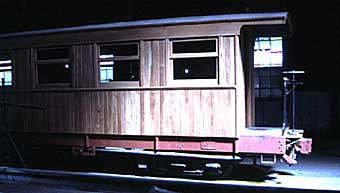
|
1st class car no. 1126. This number follows on from the 1922 batch of 25 1st class cars. Strangely it is actually on underframe no. 1125.
|
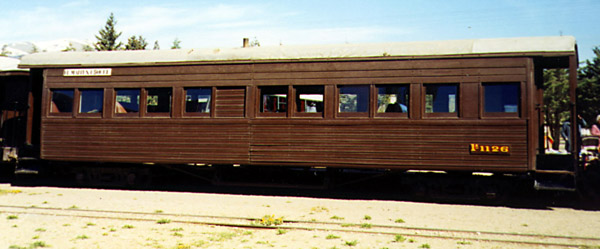
|
Dining car no. 1602. This is a new number but dining car no. 1223 carries the number from a1922 2nd class car. Another vehicle with no side doors!
|
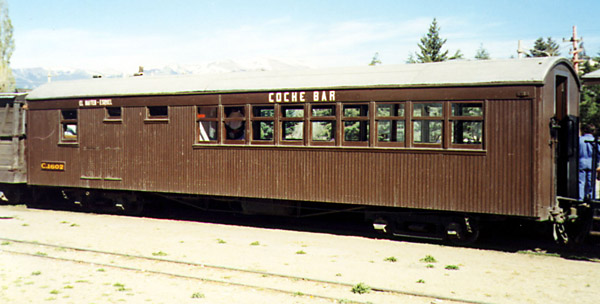
|
One of the many surplus double-deck livestock cars converted into a conventional goods van by blocking the end doors and adding sliding side doors. The ventilated sides are obviously planked up solid.
|
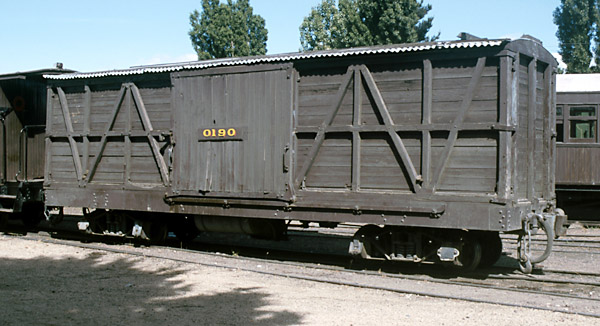
|
A chassis with fixed three plank sides. Many of the frames have steel pockets in which uprights can be placed. This has made conversion of vehicles very easy.
|
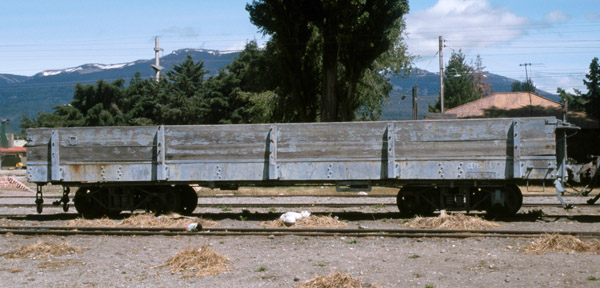
|
A 'bordes-alto' or high-sided wool wagon, but in this case without the extra doors either side of the centre ones.
|
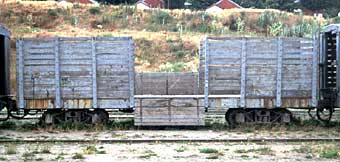
|
A track crew living van which appears to have been constructed on the chassis of a 10m flat, presumably because the extra length would be useful and the weight not a problem.
|
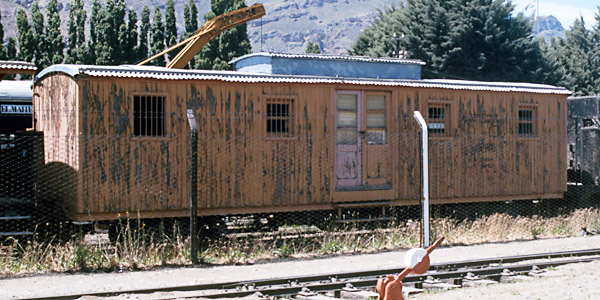
|
Another staff living van made from a normal goods boxcar with the addition of small windows, steps and a roof-mounted water tank.
|
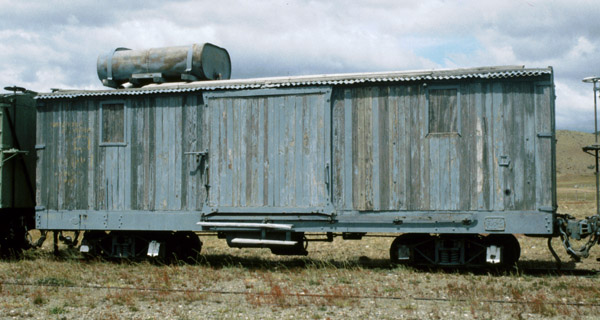
|
A much more high class staff accomodation vehicle. This is a 1922 passenger coach with its end platforms boxed in and windows rearranged. The stove also appears to have been moved to the near corner, though the chimney may be for a cooking stove. The grill on the near window looks as though it operated as a staff pay van! This vehicle is now derelict at the back of El Maitén works
|
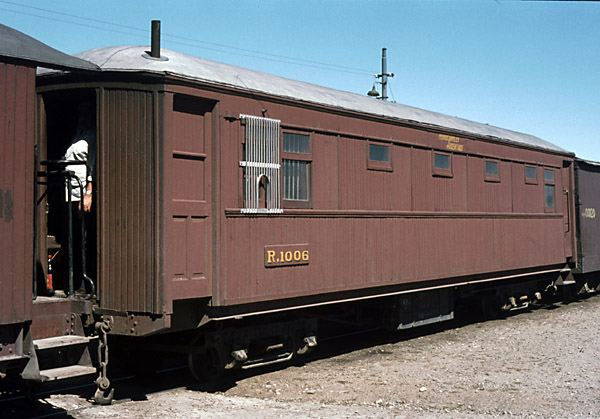
|
El Maitén crane
One unusual piece of 'rolling' stock, at El Maitén works, is a broad gauge hand crane still on its six wheels. Bringing that along from Ing. Jacobacci on a narrow gauge wagon must have been an interesting experience.
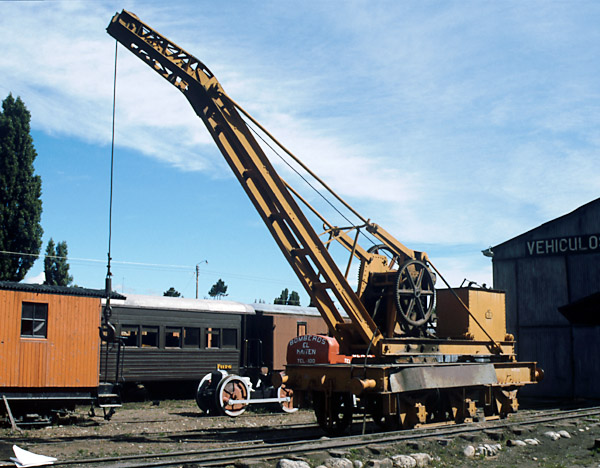
Below is a page from the Ferrocarril Nacional Roca's locomotive diagram book dating from about 1950, which, we think, shows the crane before it was transferred to El Maitén. It should be noted that it is drawn ready for running, not lifting. The diagram itself must have been drawn many years earlier as it uses English rather than Spanish.
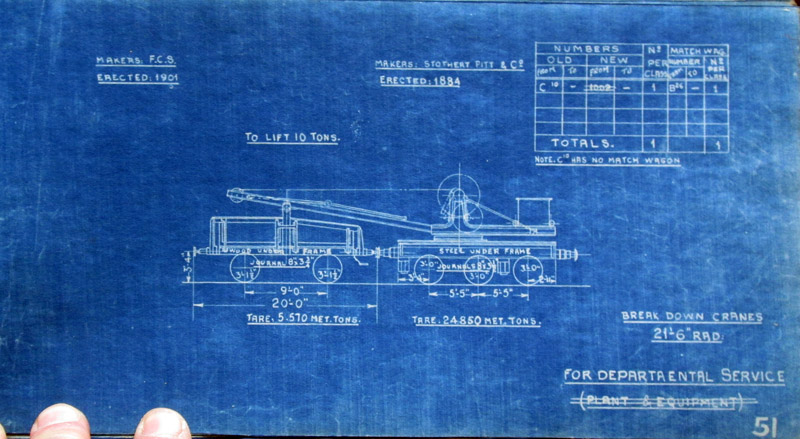
It is almost certain that for its original use as a breakdown crane it would have been fitted with a chain hoist and probably had a two part hoist, ie there would have been a pulley above the hook. For use at El Maitén, an extension has been provided to the jib, and the chain altered to a direct lift with wire which would have reduced its capacity, but speeded-up operations.
'Zorras' or PW trolleys
Samples of the track gangs' trolleys, both hand-powered and motorised, are preserved at El Maitén works. These are known as 'Zorras' in Spanish. The word can mean a female fox or vixen, but colloquially has a less respectable meaning; nevertheless this is the official term for PW trolleys even in railway stock lists.
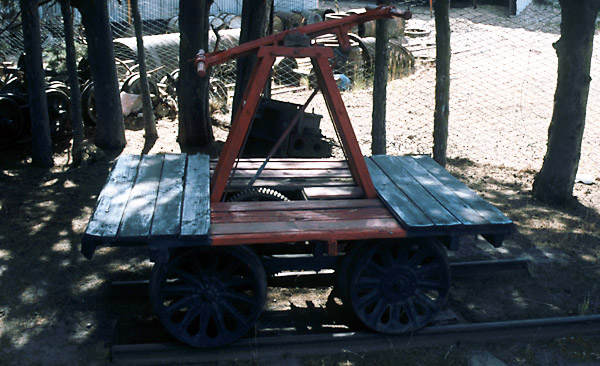
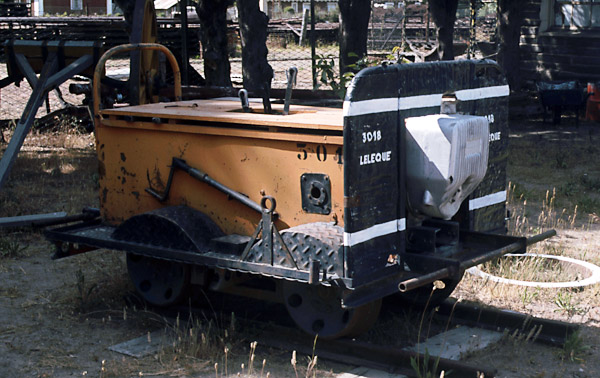
The contraption below is also at El Maitén. A photo is displayed on the 1922 locomotives page showing this machine in use at Pto. Madryn in the early 1920s. Its manufacturer is unknown.
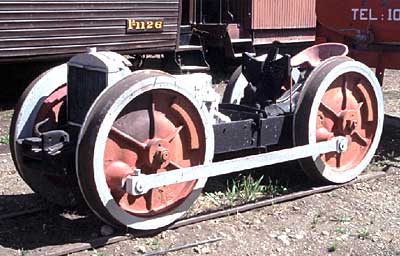
Since 1950 El Maitén has undertaken all the repairs and overhauls for the line, even serious locomotive boiler work and new car body construction being done there. The wheel store shown below reflects just one of the more routine tasks that needed doing as wagon tyres got worn on the winding route.
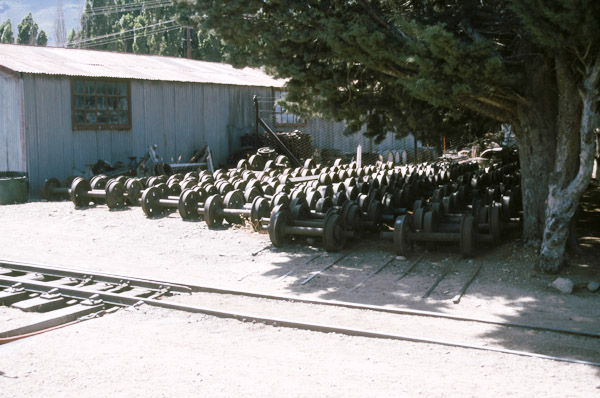
Unfortunately much of the line's rolling stock is now out of use and increasingly derelict. The photo shows a line of abandoned wagons plundered for firewood. These vehicles are at Esquel but almost every station has its line, and dozens of them lie at the junction near Ing. Jacobacci.
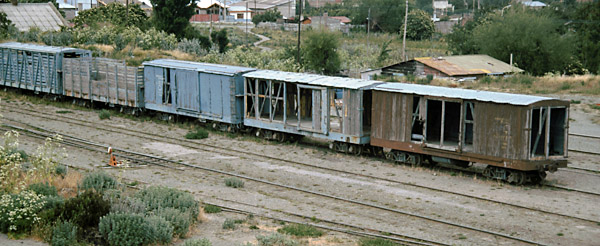
A line of ex-livestock vans, some converted for general cargo by the addition of side doors, lie at Empalme 468 west of Ing. Jacobacci. The suspicion must be that thet were moved here to reduce the likelihood of their being stripped for firewood.
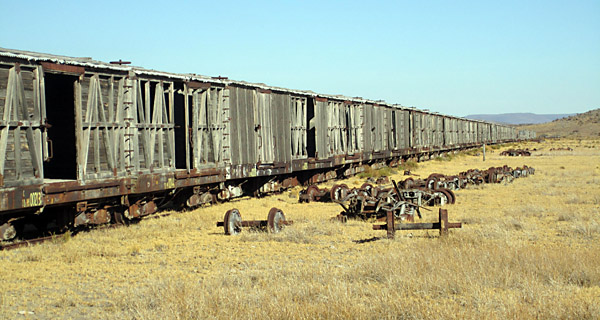
Further photos
The next page considers the operation of the Ing. Jacobacci-Esquel route. However, a number of other photos are displayed on a later page, accessed by clicking here.
References:
1 Narrow Gauge Rails to Esquel. 1999. Keith Taylorson. 23 Hanover Street, Brighton BN22 2ST. UK.
2
3 Historia de los Ferrocarriles de Argentina. 1947. Ferrocarriles del Estado. Buenos Aires.
4 Baldwin Locomotives magazine. October 1922.
5 Estadística de los Ferrocarriles en Explotación. 1940-1. Buenos Aires.
23-2-2018
|

